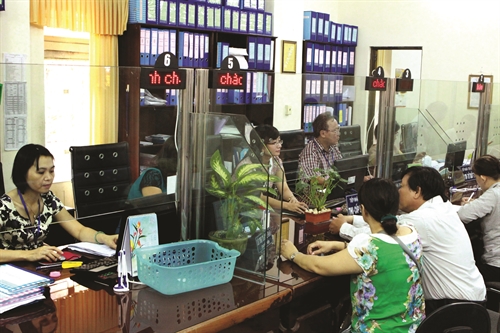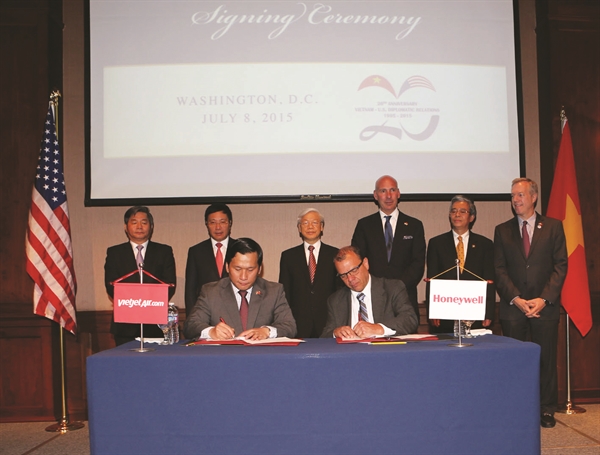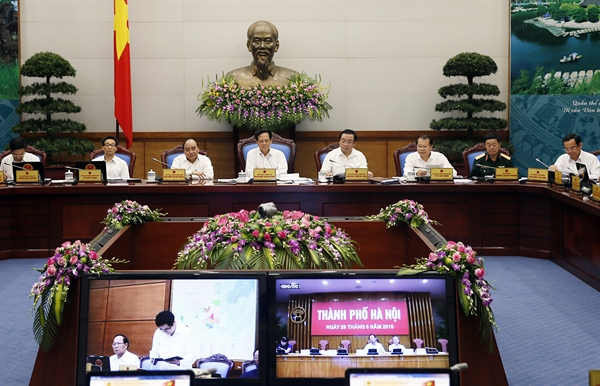Compared to the current Law on Social Insurance, the 2014 Law on Social Insurance (the Law) contains several new provisions focusing on such matters as social insurance participants, rights and responsibilities of employees, employers and social insurance agencies, and social insurance regimes and social insurance funds.
The Law, which has 125 articles arranged in nine chapters, will come into force on January 1 next year. Particularly, regulations applicable to employees working under labor contracts with a term of between one month and under three months and foreigners working in Vietnam will take effect on January 1, 2018.
Social insurance participants
Unlike the current Law on Social Insurance, the Law does not govern unemployment insurance because unemployment insurance has been stipulated in the Law on Employment.
The Law adds three more groups of subjects to the list of those covered by compulsory social insurance. They are persons working under labor contracts of a definite term of between full one month and under three months; part-time communal cadres; and foreigners working in Vietnam and possessing work permits or practice certificates or licenses issued by Vietnam’s competent authorities.
It expands the coverage of voluntary social insurance, setting no maximum age limit for persons to join voluntary social insurance. Under the current law, only working-age persons are allowed to participate in voluntary social insurance.
Under the Law, the finance inspectorate will perform specialized inspection of matters related to financial management in the social insurance sector. Meanwhile, social insurance agencies will inspect the payment of social insurance, health insurance and unemployment insurance premiums.
Particularly, trade union organizations may initiate lawsuits at court against violations of the law on social insurance which affect lawful rights and interests of employees or employee collectives.
Another noteworthy point is the provision on the monthly wage level used for calculation of social insurance contribution. Accordingly, from January 1, 2016, through the end of 2017, an employee’s wage level on which his social insurance contribution is based will include wage and wage subsidies stated in the labor contract. From January 1, 2018, onward, it will cover wage, wage subsidies and other additional amounts as stated in the labor contract.
This means that social insurance participants will have to pay premiums at a little bit higher level but they will receive much more benefits in return.
 |
| Single-window division of the Da Nang Social Security applies an automatic client-numbering system to better serve citizens __Photo: Duong Ngoc/VNA |
Rights and responsibilities of employees, employers and social insurance agencies
These issues are provided in Chapter II of the Law.
The Law abolishes the provision empowering employers to manage employees’ social insurance booklets. Instead, it allows employees to keep their own social insurance booklets throughout their working lives.
It is noteworthy that employers will provide employees with information on the payment of social insurance premiums once every six months. Annually, employees may have their periods of social insurance premium payment certified by, and receive information on social insurance contribution from, social insurance agencies.
The Law adds some rights of employees. Accordingly, employees are covered by health insurance during the period of maternity leave for childbirth or child adoption. Employees who suffer a disease on the Ministry of Health-issued list of diseases requiring long-term treatment will be entitled to sickness benefits. Meanwhile, employees who get a recurring injury or disease and have their periods of social insurance premium payment reserved may proactively seek medical assessment of the degree of working capacity loss when their health conditions become stable after treatment. If being eligible for social insurance, they will be refunded the medical assessment costs.
Social insurance regime
Under the Law, social insurance covers compulsory social insurance, voluntary social insurance and supplementary retirement scheme.
The Law devotes 48 articles - Articles 24 thru 71 - to providing for compulsory social insurance, covering sickness, maternity, labor accident and occupational disease, retirement and survivorship allowance regimes.
Sickness benefits
Under the Law, an employee suffering a disease requiring long-term treatment who needs to continue treatment though the prescribed 180-day period of entitlement to sickness benefits has expired may further enjoy sickness allowances at a lower rate for a maximum duration equaling his period of social insurance premium payment.
For an employee who has been participated in social insurance for less than 15 years and now suffers a disease requiring long-term treatment, the sickness allowance will be raised from the current 45 percent to 50 percent of the wage level used for calculation of the employee’s social insurance contribution.
Maternity allowances
Noteworthily, the Law for the first time provides for paternity leave. Upon the birth of his child, a male employee will be entitled to a paid leave of five working days, if his wife has a normal delivery, or seven working days, if his baby is born by C-section or at under 32 weeks. For a twin birth, the paternity leave will prolong to 10 or 14 working days, in case the babies are delivered normally or by cesarean, respectively. As for a multiple birth, the father will be entitled to three more working days off for each baby from the third on.
The Law adds provisions on maternity allowances for surrogate mothers and intended mothers and one-off childbirth allowances for couples of whom only the father is insured.
Under current regulations, a female worker who takes a pregnancy disability leave is entitled to maternity allowance only if she has paid social insurance premiums for full six months in the period of 12 months prior to childbirth. The Law now shortens the required time of participation in social insurance to just three months.
Labor accident and occupational disease allowances
The Law maintains the current regulations on the labor accident and occupational disease allowance regime. Meanwhile, specific contents will be included in the Law on Occupational Safety and Hygiene.
Retirement regime
The Law provides a roadmap for increasing the period of social insurance contribution required for employees to enjoy pension at the maximum rate of 75 percent to full 30 years, for women, and full 35 years, for men.
Meanwhile, the rate of pension reduction due to premature retirement is raised from one percent to two percent for each year of the period from the time of early retirement to the prescribed retirement age.
The Law also devises a schedule for increasing the age threshold for persons with working capacity loss rate of 61-80 percent to 55 from 50, for men, and to 50 from 45, for women.
Regarding conditions for receiving lump-sum payment of social insurance benefits, the Law stipulates that the policy will apply only to employees above the working age but ineligible for pensions or exiting the country for lawful residence overseas. Exceptions are persons suffering dangerous diseases such as cancer, paralysis, cirrhotic ascites, leprosy, tuberculosis and AIDS, regardless of their periods of participation in social insurance. Particularly, employees in the armed forces who are ineligible for pensions will still be entitled to receive one-off payment of social insurance benefits upon demobilization as at present if they so wish.
Moreover, the level of lump-sum social insurance allowances is increased from 1.5 times to two times the average monthly wage on which social insurance contributions are based for the period from 2014 onward.
Survivorship allowance
Under the Law, employees’ relatives who are eligible for monthly survivorship allowance will be allowed to opt for lump-sum allowance, except under-six-year children and children and spouses with working capacity loss rate of 81 percent or higher.
Additionally, the lump-sum survivorship allowance level for employees’ relatives is raised from the current 1.5 times to two times the average monthly wage used for calculation of social insurance contributions for the period from 2014 onward.
Voluntary social insurance, covering retirement and survivorship regimes, is prescribed in Chapter IV of the Law. The amendments in this chapter correspond to those made to compulsory social insurance regime.
Particularly, the Law specifies that the State will provide financial support for those who wish to join voluntary social insurance. The specific support levels will be decided by the Government depending on the balancing capacity of the state budget in each period.
Social insurance funds
Under Chapter V of the Law, the voluntary social insurance fund is consolidated into the retirement and survivorship fund - a member fund of the compulsory social insurance fund.
Costs for management of social insurance funds will be covered by profits earned from the funds’ investment activities. The Government will propose the National Assembly Standing Committee to decide on social insurance fund management costs once every three years.
While allowing social insurance funds to earn incomes through providing loans to the state budget, the Law no longer permits these funds to invest in major national economic projects as at present. Meanwhile, the investment form of “granting loans to state commercial banks” provided in the current law is modified into “depositing, or buying bonds, bills or certificates of deposits at commercial banks with good performance according to credit ratings of the State Bank of Vietnam.”
The Law provides a flexible premium payment method applicable to voluntary social insurance participants. Accordingly, employees may choose to pay premiums on a monthly basis or pay a lump-sum amount for many years to come at a level lower than the monthly premium level or pay a lump-sum for many years in the past for which premiums have not yet been paid at a level higher than the monthly premium level.
The Law also provides for organization and management of social insurance; order and procedures for participating in social insurance and settling social insurance regimes; and complaints, denunciations and handling of violations related to social insurance.- (MoLISA/VLLF)








